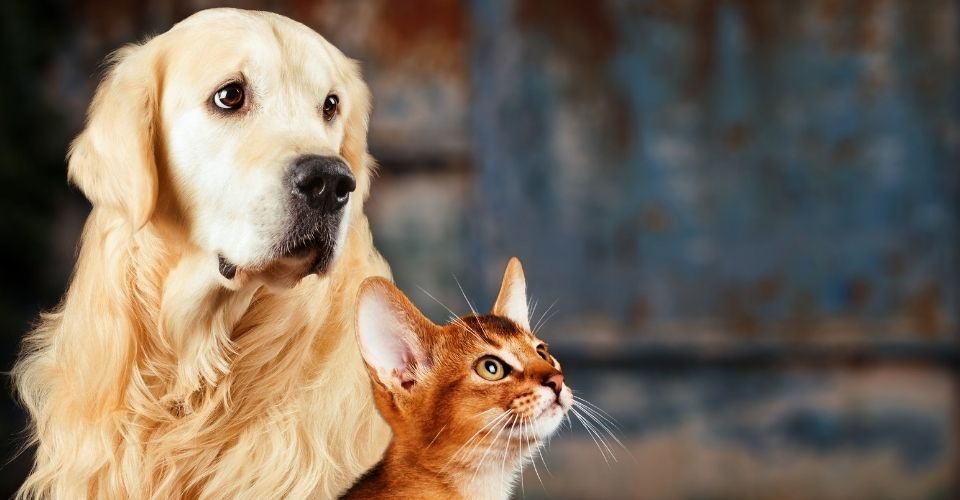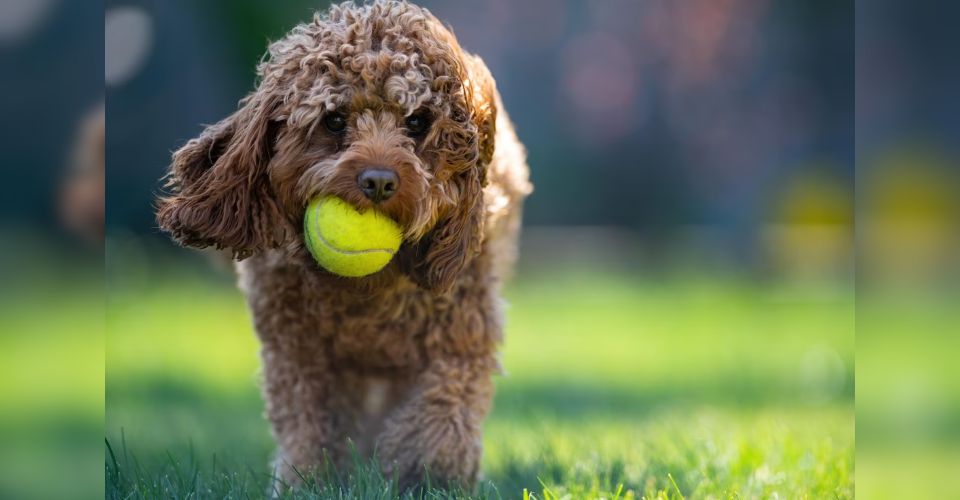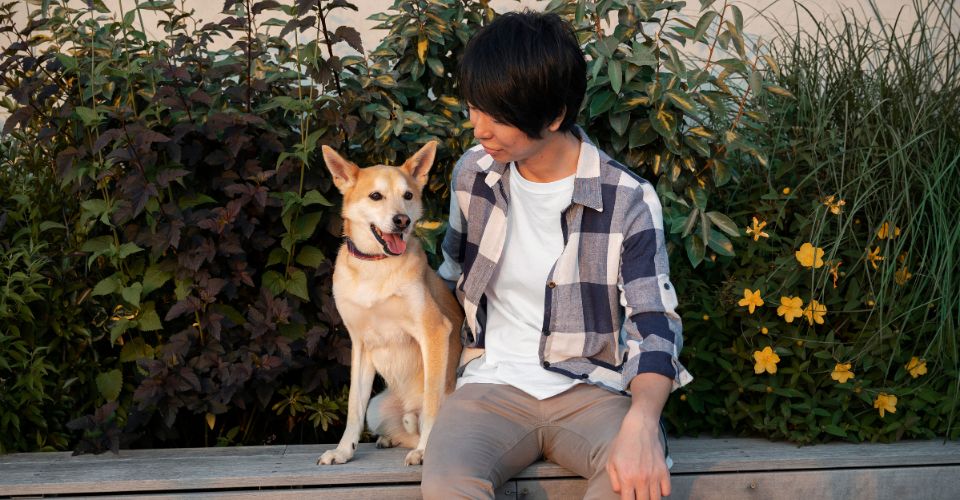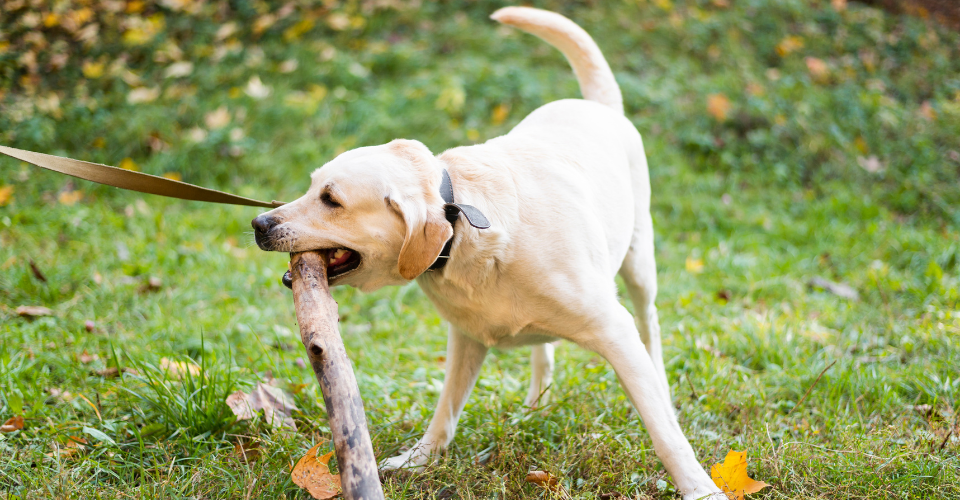If you have cats and dogs living together under one roof, you would want them to be each other’s friends rather than enemies. Your concern is valid, as most dogs, even the most friendly and calmest dogs when coming across their feline cousins, lose their cool.
And these concerns are further fanned by the notorious stories of canine-feline antagonism.
So, how to tell if a dog is aggressive towards cats? Why would he do so? What can you do? Let us answer all these questions in detail. Keep reading!
Dog-Cat Relationship Overview
A quick review of the dog-cat relationship can help us understand the detailed answer to the question.
Dogs and cats can have different kinds of relationships between them. Due to the contrasting nature of the two animals—i.e., protective and herding instincts in dogs and cats’ independent and cool character—one feels that all dogs and cats have an acrimonious relationship like Spike and Tom in the famous Tom and Jerry Show.
However, in reality, that is not always the case; in truth, most of the time, the two animals get along and co-exist pretty easily. But sometimes, a dog may be aggressive towards cats and may harm them. Therefore, as a responsible pet owner, you must be able to tell if a dog is being aggressive towards cats so that you can timely intervene before things get ugly.
How to Tell if a Dog Is Aggressive Towards Cats?
Dogs do not speak up when they are angry but behave in a certain way. So, a human can deduce their next potential move. For instance, a mere look at their body language can work as an effective measurement to judge the level of aggression.
Below are 9 ways to identify if your dog is being aggressive towards.
Blocking Cats’ Path
As a cat walks down smoothly, your dog might come in the way, intending to block her path. Protective and guards dogs will be more susceptible to this as they would perceive unfamiliar cats as a potential threat. As it is easy to observe such incidents, you should take notice of such behavior and intervene before a clash.
Standing Tall as a Cat Comes Closer
Dogs are quite protective of their items, their owners, and their family members. Though such behavior can be found in us as well, especially the children, dogs generally always tend to show this particular fondness, depending upon their breed and age.
When it comes to food, there is no exception: dogs usually do not like to share their food with other animals. Hence, if a cat comes near, your dog will probably stop eating and give the cat a stare if he thinks that cat is coming for a bite of his meal. Otherwise, he might carry on with the meal without any hesitation. In the former case, however, it becomes obvious that the aggressive mode in your dog is turned on.
If you have cats and dogs living together, you should make sure that you are serving both foods simultaneously. You should also keep a check on cat eating dog’s food as it would not only be vexing your dog but would also not be good for your cat’s health in the long term. You may also check if your aggressive dog is eating cat’s food.
Dog Barking at Cat
If your dog is aggressive towards cats, he will, most probably, become vocal when he sees her. Since dogs cannot communicate with their mouth, they generally resort to barking and growling to convey their feelings. Likewise, growling and barking in dogs are a way of expressing anger on other animals or people. In fact, growling is often observed in dogs when they feel uneasy, annoyed, or threatened.
Chances exist that your dog might growl at a cat only to act playfully and does not intend to harm her. However, you should remain cautious against potential aggressive behavior. If you are confused, a way to distinguish between a playful and an aggressive growl is to look for the other signs of aggression in dogs. A growl with a deepened tone also points towards aggression.
Dog Lunging or Taking Attacking Position
This is the most obvious body language trait to tell if a dog is aggressive towards a cat. When dogs have the instinct to attack someone, they first assume the upright position. Afterward, their almost all senses begin working sharply with the hackles raised, and they do not relax unless their perceived threat subsides. Moreover, low-pitched groans and snarls also become audible.
Your dog can take the situation to the next level by lunging at a cat as a further sign to warn her about the potential aggression. If you happen to observe any of such happening, do not wait for it to further escalate; instead, take immediate action to calm your dog down. Perhaps the best possible way to do so is to remove your dog from the scene. If your dog is anxious, you can offer him calming dog treats.
His Ears Tilt Back
A dog pinning his ears backward can have various underlying reasons: being stressed, fearful, or aggressive are the common ones. It can also mean that they are fully attentive towards only one item or person at that moment. Though the chances exist that your dog might be holding his ears backward because he wants to act playful, you should get alert when you spot your dog’s ear pointed backward.
If you find it difficult to know whether your dog is being playful or aggressive, you can verify either of these behaviors by looking for two things: dilated pupil and the presence of most of the signs discussed here.
Dog Barring Teeth
This is the most dangerous phase of a dog showing aggression toward cats. Just as a dueler unsheathes his or her sword before attacking the opponent, dogs bare their teeth when they aim to harm a perceived threat—in this case, a cat. Although there is a high chance that a dog baring his teeth will bite the cat, he will not chase the cat if she takes her cue and goes away.
Dogs can also bare their teeth in an attempt to pass a smile while being affectionate; nonetheless, it is not natural for them to do so unless they have been trained to smile. Hence, if you have a hard time finding out if your dog is smiling or being aggressive, look for any wrinkle on his muzzle and the simultaneous growling from his throat. If you find such prevalence, intervene before it is too late.
Dog Wagging Tail
Just like ears, the tail of a dog can also tell a lot about his feeling and behavior. Generally, fast tail wagging is associated with excitement, whereas the slow one means the dog is aggressive or alert. The tail can also freeze completely and harden as well.
If you happen to observe such a gesture in your canine when he sees a cat, do not overlook it as it can be a clear sign of upcoming aggression.
Dog Staring at Cat
While dog staring at you can mean many things, if your dog stares at a cat without blinking, it is a sign that he is being aggressive. As a matter of fact, your dog will try to find chances to scare away any feline by giving them a continuous intimidating glare. Furthermore, he can also make a growling sound while staring at the cat.
To tackle the situation effectively, it is best to distract your dog. Just offer him calming dog treats so that he might look away from the cat and enjoy a brief but tasty meal as he calms down.
Dog Chasing Cat
Dogs can chase cats either because of their strong herding instincts or due to potential aggression. Moreover, they generally tend to chase almost all moving objects. The threat of your dog hurting the cat he is chasing is quite low if you have a small dog breed like Pocket Pitbull, but if you have one of the high energy dog breeds or large dog breeds with strong herding instincts, things may get ugly pretty ugly if you don’t timely intervene. You should, therefore, step in to avoid any mishap.
Reasons Behind Dog Aggression Towards Cats
Having found out how to tell if a dog is aggressive towards cats, let us go through the reasons behind such undesirable demeanor in order to provide suitable solutions.
Herding Instincts and Prey Drive
Since dogs have wolf ancestors with strong herding instincts and prey drive. Hence, they tend to chase moving objects. Though it can be useful in training, the prevalence of this nature, as already discussed, leads to dogs chasing cats and can lead to serious injuries.
Therefore, it is advised that you never let your dogs with strong herding instincts unsupervised with your small pets like cats or children.
Sickness
Some diseases can make your dog aggressive. However, such demeanor is not limited to cats alone. A list of these health complications generally includes hypothyroidism, hypoglycemia, and brain inflammation.
Being in pain, your dog can become agitated by pretty much anything. Therefore, if your dog manifests unusual aggressiveness against cats, consider consulting a vet, especially if you observe any signs of sickness in the dog.
Anxiety or Fear
Anxiety can lead to sudden anger outbursts, just like in human beings. Anxiety can ensue in canines due to several reasons, such as abandonment and loneliness. Besides making your dog angry, anxiety can cause long-term health problems as well.
Guarding
Dogs, especially guard dogs, do not let anyone mess with the things or people they are attached to. Hence, they tend to act aggressively towards animals who might be getting the affection or attention of their loving owners or touching their toys or food. When a cat wanders around while they eat, dogs usually become aggressive.
Dominance and Territorial Instincts
Cat and dog living under the same roof may experience territorial disputes. Your dog might think that your cat is posing a challenge to his ‘higher’ hierarchical position by trespassing through his space. To tackle this, you should provide specific separate areas for both pets. Discipline training may also help control your dog’s undesirable behavior towards cats.
Boredom
Just as in the case of anxiety and fear, dogs might become aggressive when they feel bored. It usually occurs when they are not getting enough exercise, training, and mental stimulation. Different dogs have different levels of exercise requirements—where high-energy dogs require more exercise, lazy dog breeds won’t mind staying on the couch all day long. For mental stimulation, you can get your dog some interactive puzzle games.
Bad Training
Proper puppy obedience training plays a major role in your dog’s behavior towards felines. If your dog is obedient and responsive enough, he will contain his aggression once you say ‘no’ loudly. It, hence, prevents further escalation.
Faulty Introduction
If you have a pet cat as well and you fail to introduce her to your dog in a relaxed and neutral environment, chances are that your dog will always be aggressive towards your cat. Not appropriately introducing a cat to a dog can mess their relationship.
How to Manage Dog’s Aggression Towards Cats?
How to tell if a dog is aggressive towards cats is simple; getting rid of this behavior can be a bit difficult. However, you can try to tame your dog by following the simple points given below:
Good Interaction
As discussed above, a faulty introduction can give a severe blow to the relationship between your pet dog and cat. Therefore, it is necessary to make the first introduction as relaxed as possible. To do so, you must adhere to the following two recommendations:
- Choose a place where neither the dog nor the cat feels threatened.
- Supervise the whole meet-up and never let your cat and dog have an encounter in seclusion.
Proper Control
Dog training is an effective way to contain undesirable dog behaviors and make your dog obedient. Similarly, early socialization ad behavioral training is also crucial to make your dog behave around other pets and strangers. If you have properly socialized your dog with strangers as well as other cats and dogs, he won’t be lunging on a leash on spotting a cat or teacup dog running by.
Scent Familiarization
Scent can be an important tool for animals to recognize each other. The scent should, thus, be swapped between your pet dog and cat. To do so, an easy way is to use the same towel for both of them.
An Emergency Exit
Always be prepared for the worst, even when your cat and dog seem to be getting along just fine. To do so, assign a safe spot to your cat as an emergency exit or a safe house like a crate, just in case dogs get aggressive. Just never force your dog and cat onto each other and make the path to safety always ready for the latter.
Care
Always keep the signs of dog aggression towards cats in your mind, and observe your canine and feline pals closely when they come near each other, such as during playtime. When you have even the slightest hint of the potential aggression from your dog, simply abort the interaction between your pets.
Patience
Remember that recognizing a dog’s aggression is simple, but you will have a tough time getting rid of it? This is exactly what you need to understand! To be successful in taming your dog, you need to be patient and never act in a hasty way that might lead to more bad than good.
FAQs
How Long Does It Take For Dogs and Cats to Get Along?
It is not simple to predict. In some cases, it can take a lot longer, while in others, shorter. As a matter of fact, it all depends upon the training and environment you provide to your dog. However, a popular author on pets, Liz Palika, says that it usually takes two to three weeks for dogs and cats to get acquainted with each other.
Which Dog Breeds Are Not Aggressive Towards Cats?
A general rule is that the aggressiveness in dogs is proportional to the prevalence of herding and hunting instincts in them. Hence, dogs with strong herding and hunting instincts can be considered aggressive towards cats.
How to Know if a Dog Is Too Aggressive?
To know if your dog is too aggressive, it is better to consult an animal behaviorist. Nevertheless, bite-scale can help: dogs that bite according to or above level four are considered to be aggressive dog breeds.





